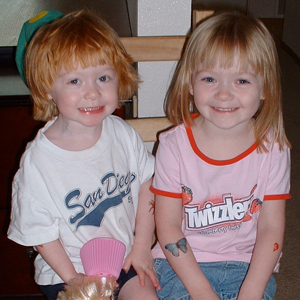You’re having twins! Whether you see it as double the fun or biting off more than you can chew, you definitely will have your hands full. You know you have to double up on the diapers and double the food, but do you also have to double the cord blood and cord tissue that you bank, too?
Let’s get some basic questions out of the way:

Cryo-Cell siblings including a pair of twins
-
Does each twin have an umbilical cord?
It doesn’t matter if they are identical or fraternal; all twins, triplets, et cetera, et cetera, have their own umbilical cords. This means that, no matter what, there will be cord blood and cord tissue that can be (SPOILER: and should be) collected and preserved for each twin.
-
Then, does each twin have its own placenta and its own source of cord blood?
Fraternal twins will always have their own placentas. In some rare cases, identical twins will, too; however, with identical twins, it comes down to when the egg splits to form the two embryos. If it splits within a few days from conception, as normal, they will form two separate placentas. If the split does not happen until 4–10 days—or later, they will share a single placenta. Identical twins make up a small proportion of twins, with the majority of them having separate placentas.
-
Is there still enough cord blood for two collections?

Cryo-Cell twins Julianna and Victoria
Why bank the cord blood from twins—fraternal or identical
As fraternal twins start as two separate eggs, they do not share an identical genetic makeup. This means that some genetic disorders that cord blood treats could affect one fraternal twin but not the other. As with other siblings, fraternal twins are more likely to be a suitable match, allowing one fraternal twin's cord blood to be used to treat the other twin who has a genetic disorder.

Cryo-Cell twins Landis and Laura
Identical twins come from the same egg and start with identical genomes, but remember that the environment can have an effect on if and how these genes are turned on and off because of something called epigenetics. Changes and mutations caused by the environment can affect many traits including disorders and even the HLA markers that determine the level of compatibility for the identical twins. One study estimated there to be an average of 359 genetic differences between the blood of identical twins alone. This means, just as with fraternal twins, twin A could form a genetic disorder that twin B does not have. It is also possible that twin 1 may not be as close of a match to twin 2 and vice versa. In the end, it is always a good idea for each twin—even identical twins—to have his or her own cord blood stored.
For either fraternal or identical twins, it is also a good idea to store as much cord blood as you can, making multiple doses available to better safeguard the whole family.
Proof in the numbers
We decided to look into the recovery rate for twins ourselves and see if and how volume and viability could be affected. As twins represent approx. three out of 100 births (i.e., 3 percent), we pulled data from our last 300 multiple births and our last 10,000 single births. Comparing the median results, we did receive 10 percent less cord blood in multi-birth collections than single-birth collections, but multiple-birth collections still had nearly 4 times more cells and nearly 8 times more CD34+ stem cells post-processing than the minimums we require.
In other words, even with twins, we were able to capture more than enough stem cells for a transfusion for each baby. We also found that our total post viability and CD34+ (stem cell) viability were a superlative 94 percent and 99 percent, respectively. This means, in addition to having a large number of stem and immune system cells, these cells were thriving and ready to aid the healing process.
What about the cord tissue?
It is also a good idea to store as much cord tissue as you can. Storing each twin's cord tissue will make multiple doses available, and with so much promise for treatment of diseases once believed to be untreatable, the need for cord tissue’s stem cells could rise dramatically in the future.